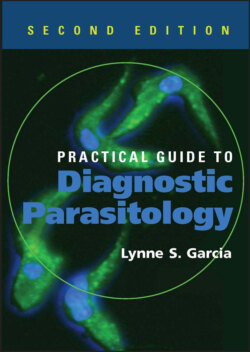Читать книгу Practical Guide to Diagnostic Parasitology - Lynne Shore Garcia - Страница 87
На сайте Литреса книга снята с продажи.
Quality Control for Preservatives
ОглавлениеPreservatives for fecal specimens are checked for quality control by the manufacturer prior to sale, generally with living protozoa. If you prepare your own fixatives, you can use the following approach for quality control. The specimen used for quality control presented below is designed to be used with fixatives from which permanent stained smears will be prepared (Schaudinn’s fluid, PVA, modified PVA, SAF, or the single-vial systems). However, this quality control specimen can also be used in a concentration; the white blood cells (WBCs) can be seen in the concentrate sediment (sedimentation concentration) or in the surface film (flotation concentration).
1. Obtain a fresh anticoagulated blood specimen, centrifuge, and obtain a buffy coat sample (try to find a specimen with a high WBC count).
2. Mix approximately 2 g of soft, fresh fecal specimen (normal stool, containing no parasites) with several drops of the buffy coat cells.
3. Prepare several fecal smears and fix immediately in Schaudinn’s fluid to be quality controlled.
4. Mix the remaining mixture of feces and buffy coat in 10 ml of PVA, modified PVA, or SAF preservative to be quality controlled.
5. Allow 30 min for fixation, and then prepare several fecal smears. Allow to dry thoroughly (60 min at room temperature or 30 to 60 min in an incubator [approximately 35°C]).
6. Stain slides by normal staining procedure.
7. After staining, if the WBCs appear well fixed and display typical morphology and color, one can assume that any intestinal protozoa placed in the same lot number of preservative would also be well fixed, provided that the fecal sample was fresh and fixed within the recommended time limits.
8. Record all quality control results. If the WBC morphology does not confirm good fixation, then describe the results and indicate what corrective action procedures were used (repeated the test, prepared new fixative).
